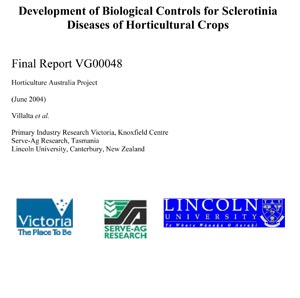|
This is the final report for project VG00048 which covers research into the biological and chemical control of Sclerotinia lettuce drop (SLD) and the use of soil amendment and cultural strategies for the integrated control of Sclerotinia diseases.
Sclerotinia diseases are a major cause of crop loss in horticultural crops (eg. lettuce, beans, carrots, crucifers, peas and others) despite the widespread use of fungicide sprays.
In some regions of Victoria and Tasmania, where lettuce are sown every year, high losses Sclerotinia minor lettuce drop (SLD) ranging from 10 to 45% were reported by growers despite the use of a regular fungicide spray program.
Inconsistent chemical control and increasing public concerns over fungicide residue levels were major issues of concern to the industry and therefore this project was funded to find alternatives which gave more sustainable control of Sclerotinia diseases.
This project examined the effectiveness of well developed biological control agents for reducing inoculum and controlling disease, and compared a range of application methods to improve their efficacy using lettuce as a model system.
The project evaluated strategic application of fungicide treatments for control of sclerotinia disease on lettuce and beans. Soil amendment strategies were also evaluated in combination with the use of registered chemicals and cultural strategies examined for their potential to reduce disease pressure and improve SLD control.
The overall aim of the project was to provide growers with new options for the integrated control of Sclerotinia diseases and better inform them of the most appropriate use of fungicide treatments for disease control in their farms.
Authors
|
| Oscar Villalta |
Ian Porter |
| Tuula Launonen |
Denise Wite |
| Hoong Pung |
Susan Cross |
| Alison Stewart |
Nimal Rabeendran |
| Kirstin McLean |
John Hunt |


Outcomes :
- Control of SLD was improved in farms by 80 to 96% with the use of new strategic application of procymidone (sold as Sumisclex™ or Fortress™) sprays. Improved application can improve its efficacy and therefore growers are advised to modify their fungicide application methods for maximum disease control.
- The new fungicide BAS 510 (BASF – boscalid) was shown to be as effective as procymidone in controlling SLD and bean white mould and therefore it has the potential to replace procymidone or for use in alternation with procymidone.
- The treatment of seedling growing mixes in nurseries was the most effective method for delivering Trichoderma biocontrol agents into a seedling transplant system.
Two commercial composted pine bark mixes were identified as suitable substrates to incorporate Trichoderma.
- In the field, biocontrol treatments did not give the same consistent and effective control of SLD provided by fungicide treatments and were not effective in reducing inoculum in soil.
This was due to the inability of biocontrol agents (BCAs) to establish in soil at levels considered optimal for effective biocontrol.
A better understanding of the compatibility of BCAs with farm practices (eg fertilisers, pesticides) and soil characteristics (eg organic matter) conducive for maximum growth of BCAs is required to improve the field efficacy of biological treatments.
- BQ-Mulch (green manure crop) used in rotation with lettuce in a Tasmanian soil reduced Sclerotinia disease by suppressing infection and improved soil characteristics.
- Seedlings of onions, beets and spinach, which have upright foliage, were less susceptible to Sclerotinia infection and therefore can be selected for crop rotations in high Sclerotinia pressure sites.
Acknowledgements :
There were many people and organisations that provided assistance to make this research possible. They include:
- Susan Pascoe, Barbara Czerniakowski, Rosa Crnov and Peta Easton (PIRVic, DPI Vic) for their invaluable assistance in conducting laboratory and field work and in compiling data. Nigel Crump for advice on soil amendments and Craig Murdoch for technology transfer.
- Field trials at Cambridge and Margate in southern Tasmania were conducted with the assistance of Dennis Patten and Lee Peterson, Serve-Ag staff based in Hobart. Other Serve-Ag staff who also assisted in this project were Peter Aird and Sarah Lamprey.
- Mark Shakelton at CSIRO Entomology, Perth, conducted plant analysis for isothiocyanates in brassica green manure tissues.
- The staff at the PIRVic, Department of Primary Industries, Knoxfield for their assistance in establishing and harvesting field trials.
- The lettuce growers in Victoria and Tasmania who graciously allowed trials on their farms and provided assistance in their establishment, maintenance and harvest.
- The commercial nurseries in Victoria and Tasmania which graciously produced seedlings for trials and allowed experiments on their glasshouses and provided assistance in their establishment and maintenance.
- Biometricians Graham Hepworth and Nam Nguyen for their input into trial design and data analysis.
- Agrochemical companies for providing samples of fungicides and other companies for supplying biocontrol products for laboratory, glasshouse and field work.
- The authors thank the members of the advisory group, Kon Koroneos, Stan Velisha, Frank Ruffo for their valuable contribution to this project.
|

